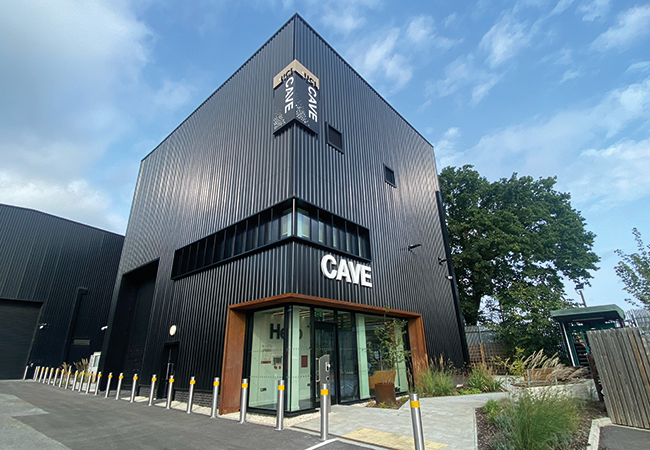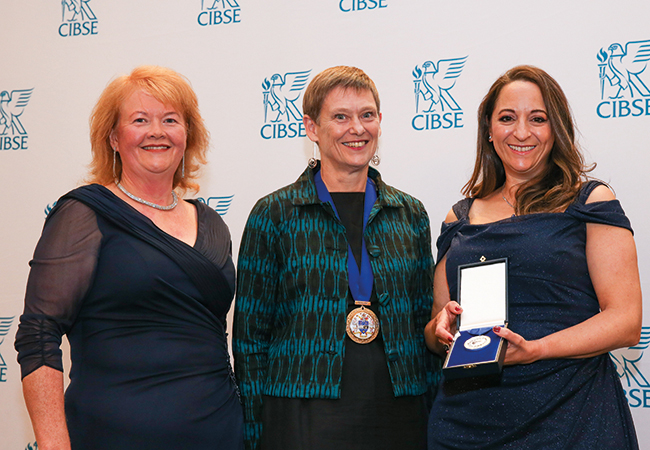
On 15 May 2021, Leicester City beat Chelsea 1-0 to win the FA Cup final in front of the UK’s biggest crowd since the coronavirus pandemic began. As well as 21,000 fans, officials, and dignitaries (including Prince William), there was a busy team of academic researchers at Wembley that day.
The researchers were part of the government’s Events Research Programme (ERP), which was evaluating the risks of airborne transmission of viruses associated with attendance at large-scale events.
During the pandemic, there was significant concern that poor ventilation could put key workers, passengers, and attendees at mass-gathering events at risk of airborne infection.
The Wembley final was one of 90 live events – including the Euro 2020 men’s football championships – monitored at 10 indoor and outdoor venues under the environmental study of the ERP between April and July 2021.

Measuring emissions from two cars at Cave
The team had started setting up the environmental study a month earlier, as part of the ERP. It was designed to collect data related to risk of airborne transmission of viruses. This involved observing people, collecting data on IAQ and movement of air, and testing surfaces for SARS-CoV-2.
The real-world evidence on indoor air quality formed the basis of ventilation advice to government and industry that minimised risks at events and enabled the country to reopen public venues in July 2021.
The work was published in the BSER&T article ‘Measurement and rapid assessment of indoor air quality at mass-gathering events to assess ventilation performance and reduce aerosol transmission of SARS-CoV-2’ (bit.ly/CJDSM24). This was awarded the Dufton Silver Medal for research at last month’s CIBSE President’s Awards.
The research has led to a valuable and lasting legacy – UCL’s Controlled Active Ventilation Environment (Cave) laboratory, a facility designed for the study and evaluation of the effects of ventilation, air quality and thermal comfort in built environments.
The emergence of Cave
One consequence of the Covid-19 research has been the creation of the Controlled Active Ventilation Environment (Cave) lab at UCL’s Dagenham site.
It enables research to take place on indoor and outdoor air quality, ventilation and resilience to airborne hazards in the built environment.
UCL’s Department of CEGE in the Faculty of Engineering Sciences was handed over the 216m2, 9.5 m-high laboratory last summer. Over the past year, the Cave team has been trialling the ventilation facility, and installing over £300K worth of air quality and airflow monitoring instruments, databases and dashboards. The team are now preparing for the installation of a full-scale two storey modular building in the new year.
Experiments have already taken place, including one on the suitability of art-storage facilities and the impact on air quality of idling cars.
The ERP studies followed on from work done by the air quality and fluid mechanics groups at the Department of Civil Engineering, UCL who had previously done research on ensuring the safety of bus drivers and waste disposal operatives, who worked throughout the pandemic. Our team was approached because we were part of a consortium that had just been awarded an EPSRC rapid Covid-response grant to research airborne infection reduction through building operation and design (Airbods) for SARS-CoV-2, led by Loughborough University’s Professor Malcolm Cook.
There was pressure to quickly develop a way to evaluate ventilation provision in the leisure sector and to assess the risk of transmission among large groups of people who weren’t necessarily in close proximity to each other. The field studies work originally proposed by UCL was not designed for the scale of the ERP, but by assembling a wider team of researchers from the Airbods consortium, and with the help of additional funding from the DCMS, we managed to carry out the study.
Undertaking the environmental study was daunting – there was no prior research into how well-ventilated the venues typically were, and the challenge was made greater by the sheer pace of the ERP; from conception to reporting took only three months. The goal was to evaluate as many locations as possible, give evidence on the state of venues around the UK, and provide guidance on improving safety at events. We boiled the problem down to one of air quality, which was assessed by measuring CO2, a proxy for exhaled breath.

Dr Malki-Epshtein (right) receives the Dufton Silver Medal from CIBSE President Fiona Cousins (centre) and CIBSE CEO Ruth Carter
We installed rapid and temporary environmental surveys throughout the venues, with data reporting directly to an online dashboard and database, allowing us to analyse data quickly.
As well as measuring CO2 at a large scale, we needed to develop: a classification system for the venues; a set of air quality metrics benchmarked against industry guidelines and government advice; and an understanding of key types of spaces to identify vulnerabilities.
Finally, we considered how much time people spend at an event, as longer events increase the likelihood of encountering infected people and spending significant time breathing in air containing virus particles.
We monitored 189 spaces and, for most of the time, air quality was good or excellent, even at occupied events. Typical problem areas included toilets, stairwells, corridors and concession stands. These may not have been designed for prolonged occupancy, so became IAQ hot spots when occupancy was increased – because of long queues, for example. Spaces where ventilation could be improved were identified and mitigations tested to reduce the risk of airborne transmission of respiratory diseases.
The study proved that high-resolution CO2 monitoring is inexpensive, can be deployed rapidly, and can quickly identify areas where exhaled breath is building up in indoor spaces. However, this is more useful as a temporary survey to identify issues with ventilation effectiveness and occupancy rather than a long-term monitoring solution.
There is growing evidence that a wide range of building types may not always be ventilated adequately, especially in the winter months. This may be because of operation, maintenance, design, or refurbishment and repurposing of existing buildings in operation. Additional consideration of the ventilation requirements in Building Regulations may be needed to improve IAQ and build resilience against future infectious diseases.
Teams from the Airbods consortium are still working on research relating to these studies, aiming to improve ventilation effectiveness further.
About the authors
Dr Liora Malki-Epshtein is director at Cave, associate professor at the Department of Civil, Environmental and Geomatic Engineering (CEGE), UCL, lead of the ERP environmental study and lead author of the Dufton Silver Medal-winning paper
